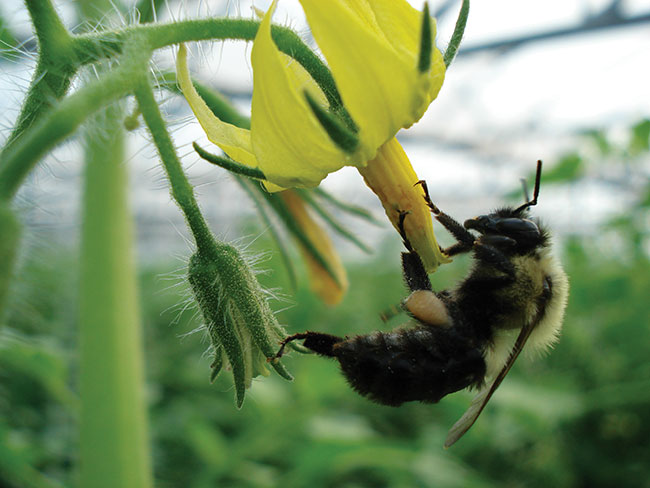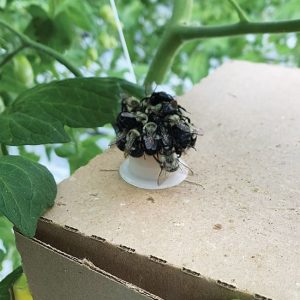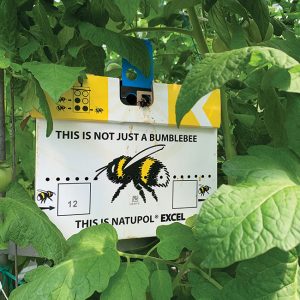
Features
Crop Culture
Inputs
Vegetables
Six tips for healthy greenhouse pollinators
Bumblebees may be self-sufficient outdoors, but to get the most from their pollination activity in greenhouses, it’s important to understand their needs and how to best meet them.
June 1, 2021 By Melissa Hargreaves
 Bumblees use a unique technique to access pollen deep within tomato flowers. All photos courtesy of Koppert Canada
Bumblees use a unique technique to access pollen deep within tomato flowers. All photos courtesy of Koppert Canada
In the late 80s, the bumblebee was discovered to be the best pollinator for greenhouse tomatoes. Since then, they have been used in almost all instances of greenhouse tomato production.
The secret to their success is their “buzz” pollination technique.
Tomatoes have pollen-bearing stamens hidden deep within the flower. Most insects are unable to reach these stamens, causing poor fruit development and small yields.
Bumblebees, on the other hand, are able to vibrate these flowers to release the pollen that is firmly held by the stamen. While this type of pollination increases the overall yield of the crop, greenhouse growers sometimes forget that bumblebees also require attention. They cannot be placed, then forgotten.
Here are six key factors to be aware of when using bumblebee hives in your greenhouse.
Sugar water
At the bottom of each hive, you will find a bag of sugar water. This acts as a nectar source and is important for crops like tomatoes which do not produce nectar.
Due to the lack of nectar from the crop, it is important to have a constant source of sugar water, either with the sugar water bag underneath the hive, or if that is depleted, in supplemental bags placed on top of the hive stocks.
When bees run out of sugar water, they can become aggressive, stinging workers and fighting with other hives to steal sugar water. If there is not a sufficient amount of nectar inside, the bees will leave the greenhouse to find it once the vents begin to open, causing a drop in pollination levels.
Pollen
In most situations, healthy tomato crops provide more than a sufficient amount of pollen for the hive to develop properly, provided that an excess of hives have not been introduced.
Pollen provides fat and protein. Too many hives and/or pollination levels that are too high can lead to an insufficient amount of crop pollen and result in the starvation of hives. Telltale signs include the appearance of extremely dark, bruised flowers and aggressive bee activity. This can dramatically reduce the life expectancy of hives, increasing pollination input costs.
It is best to try and maintain a medium level of pollination or four to five bites per flower. In the event where there is an insufficient number of open flowers in the crop or perhaps none at all, hives need to be fed a small amount of pollen every other day, roughly a quarter of a tablespoon.
Pesticide Exposure
In greenhouse pollination, the majority of significant pesticide side effects stem from neonicotinoids, especially imidacloprid (Intercept). Even extremely low doses, such as the treatment of plants at propagation or contamination in recirculated solutions, can cause serious side effects that sometimes last for months. It is best to follow product recommendations and research potential side effects, which are typically listed by reputable bumblebee producers.
Artificial Lighting
Artificial lighting is known to create a more challenging pollination environment. This is because bees become disorientated with an insufficient amount of natural light, especially during the winter months. Artificial lighting also speeds up hive development, expediting a decrease in the viability of the hive compared to a non-lit greenhouse.
When introducing hives into greenhouses that use artificial lighting, the hives need to be timed to open and close every day on a specific schedule. They should be open once the sun reaches the side wall of the greenhouse, and two hours prior to sundown. This way, the bees are foraging with sufficient natural light. Roughly, the hives in eastern Canada should only be open between 10 am and 3 pm, giving the bees enough time to return home before sunset.
Automatic openers are available and can be easily connected to environmental control systems, replacing the labour of opening and closing hives on a daily basis.
Hive Placement & Removal
Here are a few important tips when placing hives inside the greenhouse.
First off, it is best to always face the hive doors away from each other, so the bees do not drift. Bee drift causes worker bees to move from one hive to the other, eventually starving the brood and rendering the hive useless.
Secondly, when stacking hives on top of each other it is important to place the newest hives at the bottom of the stack. This will make things easier when hives need to be pulled out of the greenhouse.
Third, hives should be placed in a location that is easily accessible to the central greenhouse pathway for visibility, as this is their runway.
To ensure a healthy bumblebee population, removing hives is also extremely important for many reasons. Old hives can steal sugar water away from a new hive. They can also increase the chances of developing pests and diseases, which can spread from colony to colony. Furthermore, they are known to drain worker bees from newer hives, as the bees are attracted to larger colonies.
Air Conditions
The greenhouse environment can also cause pollination issues.
Higher temperatures (e.g. summertime, over 30°C) can cause the bees to stop foraging for pollen, as they are more likely to be fanning the brood. This is when worker bees use their wings to ventilate the hive, keeping the larvae cool in the intense heat.
A high relative humidity (over 85% RH) will cause the pollen to become sticky and adhere to the stamens. Many growers tend to add extra hives to compensate for poor air conditions, however this only compounds the situation, particularly when the temperature and humidity levels return to normal and there are too many hives competing for the same flowers.
Care for the bees
In these last 30 years, we have learned how important bumblebees are to commercial greenhouses and how to optimize each hive, gaining respect for these pollinators in the process.
At the end of the day, these six key factors should always be in the back of your mind when using bumblebee hives in a greenhouse. Each one will affect the bumblebees in a specific way, which will have an effect on pollination, and ultimately, the final product.
Melissa Hargreaves is an inside technical consultant and media coordinator at Koppert Canada. She can be reached at MHargreaves@koppert.ca .
Print this page

